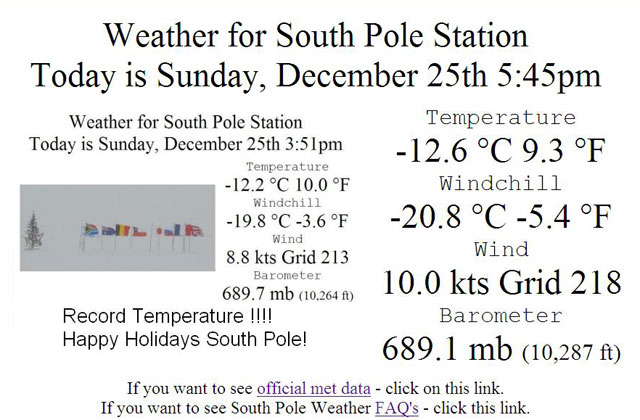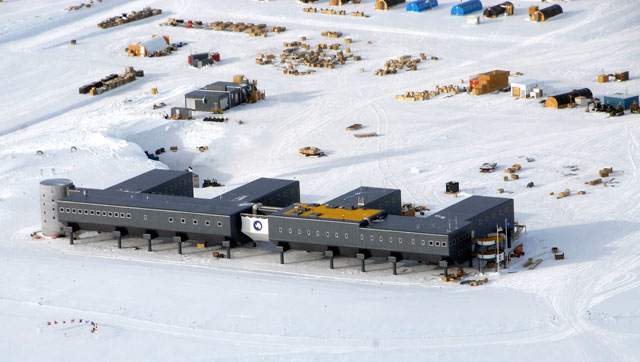|
Heat waveSouth Pole hits record high temperature on Christmas DayPosted December 29, 2011
Updated January 1, 2012
A rare white Christmas at the South Pole brought with it a record-breaking heat wave — at least for a day. The temperature officially hit 9.9 degrees Fahrenheit (minus 12.3 degrees Celsius) about 3:50 p.m. on Dec. 25, according to South Pole Station Those sorts of temperatures may not qualify as mild to some people, but consider that the average annual temperature at the South Pole is about minus 56.9F (minus 49.4C). In the summer, from late October to early February, the average is closer to minus 26F (minus 32C), Marzette said. “We like to call this our little Christmas miracle that we ended up getting snow and getting a record high for the books,” Marzette said a few days after the record-breaking day, when temperatures had returned to mid-summer norms, about minus 15F (minus 26C). 
The South Pole Station scroll shows the record temperature on Dec.25 (though the official record is 9.9F).
The snow was certainly an unexpected bonus. Precipitation in the continental interior is normally very light. Ice crystals are the most common form of precipitation at the South Pole. Ice crystals often fall out of a clear sky, glittering like tiny diamonds in the sunshine, and sometimes creating atmospheric phenomena like sundogs. Larger snow grains often accompany storms, while actual snowflakes usually only occur at the height of summer, from mid-December to mid-January, when temperatures are at their warmest. The cause of the sudden spike in temperature was a system from what’s called grid south of the research station, bringing winds of up to 13 miles per hour. It’s very uncommon to get wind from that direction, according to Marzette. (The South Pole Station grid system uses Cartesian coordinates, which specify each point uniquely in a plane by a pair of numerical coordinates. Grid north at Pole is defined as the line representing the prime meridian or zero line of longitude and is called “north.” The 180-degree line from South Pole is referred to as “south.”) When the system did blow through, the temperature started to rise rapidly, beginning at around 6 a.m. on Dec. 25, after starting just below 0F. By 3:50 p.m., the mercury had climbed to 9.9F, and hit the mark again around 10:50 p.m., before dropping as quickly on the following day. Matthew Lazzara The preliminary assessment of the data from those two sites, about 60 miles to the grid east (Nico) and grid north (Henry) of the South Pole, show that the Nico AWS hit 17.2F (minus 8.2C) and the Henry AWS reached 16F (minus 8.9C) on Dec. 25. The previous record at the former was 7F (minus 13.9C) on Jan. 4, 2010, while the Henry AWS had recorded a previous high of 5.9F (minus 14.5C) on Jan. 5, 2010. The warmest temperature ever recorded in Antarctica occurred on Jan. 5, 1974, hitting a balmy 59F (15C), at Vanda Station, a small research base that once operated on the shores of Lake Vanda in the McMurdo Dry Valleys The Russian Vostok Station still holds the record for coldest temperature — not just in Antarctica but the world. On July 21, 1983, the mercury bottomed out at minus 128.6F (minus 89.2 °C). The coldest day at the South Pole was minus 117F (minus 82.8C) on June 23, 1982.
|



For USAP Participants |
For The Public |
For Researchers and EducatorsContact UsU.S. National Science FoundationOffice of Polar Programs Geosciences Directorate 2415 Eisenhower Avenue, Suite W7100 Alexandria, VA 22314 Sign up for the NSF Office of Polar Programs newsletter and events. Feedback Form |


